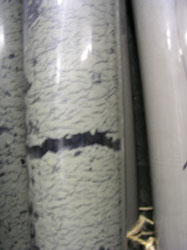

 | |||||||||
|
|
Journals 2006/2007Miriam Sutton
August 26, 2006 AM Location: Saglek Bank (57° 29' 21.61" N, 59° 26' 03.04" W) While I was visiting the thousand-year old mud in the Core Storage Bin yesterday, I noticed several of the cores had large gaps throughout the core sample. Some of the cores were even bulging at the top from so much pressure inside the sample. I questioned the scientists about the "expanding" samples to learn why some cores expanded and others did not. Some of the samples contained in the storage bin were collected on the previous research cruise from a Placentia Bay region near shore to Newfoundland rather than far out to sea like the ones collected this month. Sediments closer to shore tend to contain more organic matter than sediments further out to sea. The organic matter deposited within the sediment comes from the decay and run-off of biological matter. (See Core Sample photo below.)
As the organic matter begins to breakdown, or decomposes, gas is released. The cores are sealed for storage so the gas has no way of escaping when it begins to expand. As the gas molecules expand, the sediment is compressed closer together resulting in spaces within the core sample. Today's Activity: Place a balloon over the mouth of a plastic soda bottle filled with carbonated soda. Be sure you have a tight seal between the balloon and the bottle. Place the bottle outside in the sun for a few hours and observe the changes in the balloon. Describe to a friend what caused the changes in the balloon as the soda began to get hotter. Word of the Day: Decompose REMINDER: Record today's Sea Surface Temperature (SST) and the Air Temperature on the data table you created from the August 05 journal entry. |
||||||||
